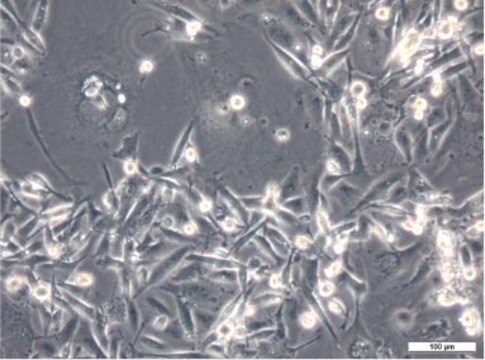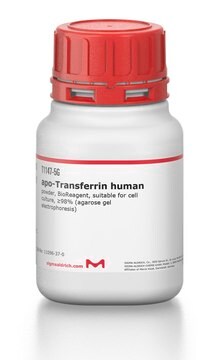推荐产品
生物源
human breast
包裝
tube of 5 μg 98102210-DNA-5UG
pkg of vial of cells 98102210-1VL
增長模式
Adherent
染色體組型
45,XX,1p-,-6,8q+-,12p+,14q+,17q+
形態學
Epithelial-like
產品
Not specified
受體
EGF
技術
cell culture | mammalian: suitable
相關疾病
cancer
運輸包裝
dry ice
儲存溫度
−196°C
細胞系來源
Human Caucasian breast epithelial
細胞系描述
HMT-3522 S1, also known as HMT-3522/wt, is a subline that has been derived from HMT-3522. The parent line was established from a benign breast tumour of a 48 year old woman and has undergone spontaneous malignant transformation. It was grown on collagen in serum-free media without antibiotics from explantation onwards. A mutation at codon 179 of the p53 gene was detected during establishment of the parent line. HMT-3522 S1 is a continuation of this line from passage 34 growing without collagen. Subline S2 (Sigma catalog no. 98102211) has been isolated by culturing S1 cells from passage 118 in serum-free media without epidermal growth factor (EGF). The third subline, T4-2 (Sigma catalog no. 98102212) was established from S2 at passage 238 and is the only tumorigenic line in nude mice out of the 3 sublines. S2 and T4-2 grow on collagen-coated flasks. HMT-3522 S1 is near-diploid, but an evolution of karyotype has been observed by regular chromosomal analyses. The expression of cytokeratin 13, 14, 17 and 18 and vimentin has been reported. Expression of EGF-R, c-erb-B2, N-myc, c-ras-Ha1, c-ras-Ki2 and N-ras was shown to fluctuate slightly with passage number. The cells have tested negative for estrogen receptor, c-erbA1, c-erb-A2, int-2 or hst-1. During propagation growth factor requirements decreased simultaneously with amplification and overexpression of c-myc protooncogene. In a three-dimensional basement membrane culture assay the phenotypic characteristics of normal breast tissue in vivo are recapitulated. This cell line has remained non-tumorigenic for more than 400 passages. Publications using this cell line must refer to the original paper. Any sublines created must include the name HMT-3522 in the designation, but a short name may be used in the same paper.
DNA分析
Not specified
培養基
DMEM / Ham′s F12 (1:1) + 2 mM Glutamine + 250 ng/ml insulin + 10 μg/ml transferrin +10E-8M sodium selenite + 10E-10M 17 beta-estradiol + 0.5 μg/ml hydrocortisone + 5 μg/ml ovine prolactin + 10 ng/ml EGF
例行更新培養
If starting from a frozen ampoule the cryoprotectant should be removed. Add thawed cells to a conical based centrifuge tube e.g. 15 ml tube; slowly add 4 ml of culture medium to the tube. Take a sample of the cell suspension, e.g. 100 ul, to count cells. Centrifuge the cell suspension at low speed, i.e., 100-150 x g for a maximum of 5 minutes.Split subconfluent cultures using 0.25% trypsin or trypsin/EDTA; 5% CO2; 37 °C. Seed pre-coated flasks at 2-4 x 10, 000 cells/cm2. Cells detach slowly; add same volume of trypsin inhibitor as trypsin used, centrifuge and reseed cells in collagen IV coated flasks. Medium is serum-free, therefore trypsin inhibitor is essential. S1cells can be slow in spreading out after subculture and may take 2-3 days to attach. Good growth occurs 5-7 days after subculture.
Cells should be frozen in (45% conditioned media: 45% fresh media) with 10% DMSO.
Cells should be frozen in (45% conditioned media: 45% fresh media) with 10% DMSO.
其他說明
Additional freight & handling charges may be applicable for Asia-Pacific shipments. Please check with your local Customer Service representative for more information.
我们的科学家团队拥有各种研究领域经验,包括生命科学、材料科学、化学合成、色谱、分析及许多其他领域.
联系客户支持


